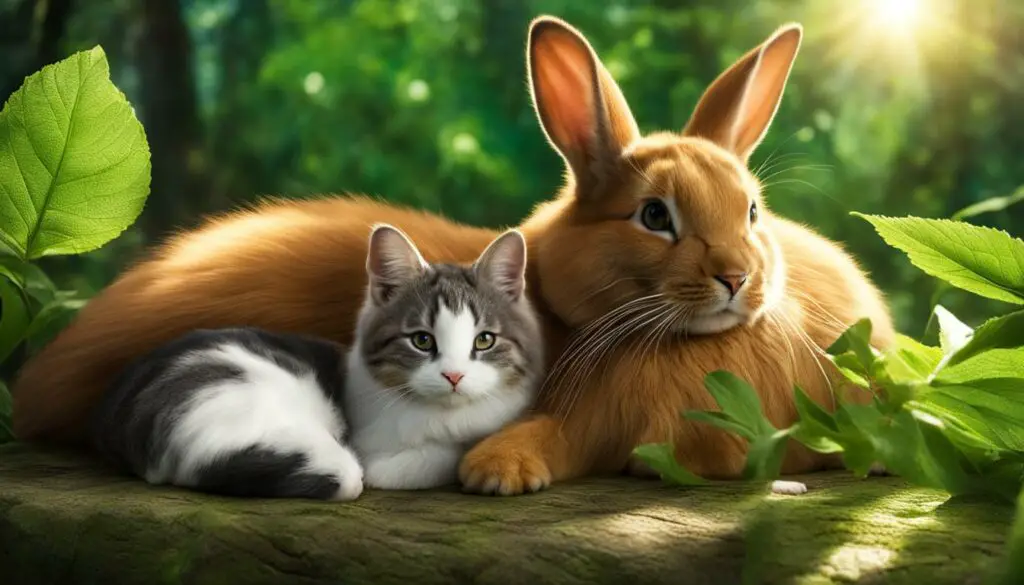When it comes to bringing both cats and rabbits into your household, you may wonder if they can get along. While cats are natural predators and rabbits are prey animals, there are circumstances where they can form a harmonious relationship. Factors such as the age of introduction, temperament of both animals, and the size/breed of the rabbit can all play a role in determining how well they get along.
Introducing cats and bunnies at a young age increases the chances of them getting along. It is also important to consider the temperament of both animals. Cats that are calm and submissive have a better chance of getting along with rabbits, while rabbits that are assertive, but not aggressive, are more likely to establish a harmonious relationship.
Matching cats and rabbits that are similar in size can also help promote a balanced relationship. It’s important to introduce them slowly and carefully, providing separate living spaces initially and gradually allowing them to interact under supervision.
Understanding and managing their natural instincts, such as a cat’s prey drive or a rabbit’s territorial behavior, is crucial in creating a safe environment for both animals. Additionally, providing separate playtime for your cat can help satisfy their hunting instincts and redirect their focus away from the rabbit.
While it is possible for cats and rabbits to get along, it’s important to prioritize the needs of both animals and be prepared for the possibility that they may always need to be separated. Each cat and rabbit are individuals, and it may take time and effort to establish a bond between them.
Key Takeaways:
- Age of introduction plays a role in cat and bunny compatibility.
- Temperament of both animals is important for a harmonious relationship.
- Matching the size of the cat and rabbit can promote a balanced dynamic.
- Slow and careful introductions are crucial for their safety.
- Providing separate playtime for your cat can help satisfy their hunting instincts.
Cats are predators, rabbits are prey
When considering the compatibility between cats and rabbits, it’s important to recognize their natural instincts. Cats are natural predators, with a keen hunting instinct. They possess sharp claws and teeth, and their agility allows them to stalk and pounce on their prey. On the other hand, rabbits are prey animals. They have evolved to be alert, quick, and agile in order to evade predators.
This predator-prey dynamic is deeply rooted in the behavior of both cats and rabbits. Cats may see rabbits as potential prey, triggering their hunting instincts. This can lead to chasing, pouncing, and even aggression towards the rabbit. Similarly, rabbits may perceive the presence of a cat as a threat, causing them to exhibit defensive behaviors such as hiding, thumping their hind legs, or even charging at the cat.
Understanding this predator-prey relationship is essential when introducing cats and rabbits. It’s important to create a safe and secure environment for both animals, ensuring their well-being and minimizing the risk of harm or stress.
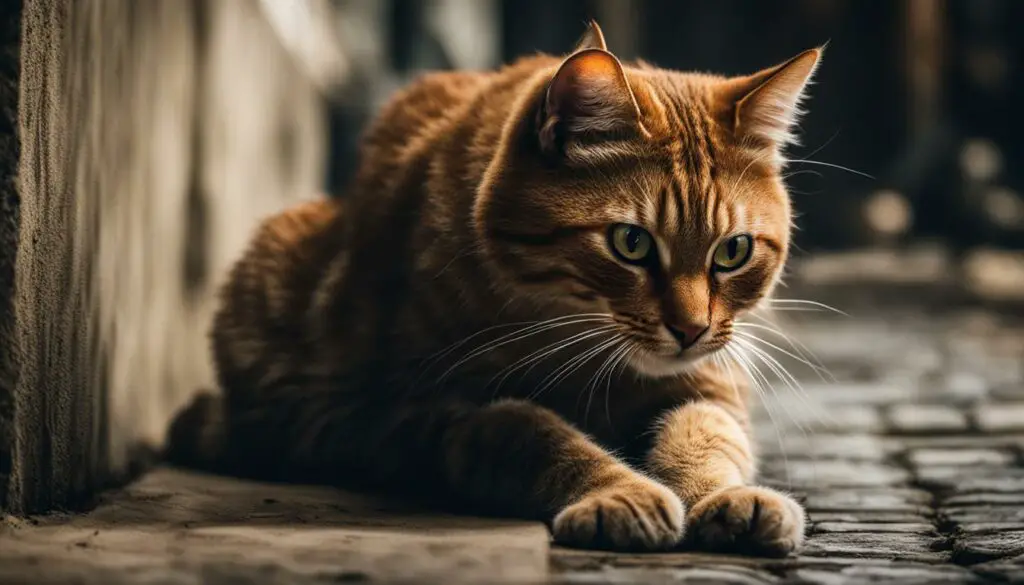
| Cats | Rabbits |
|---|---|
| Cats are obligate carnivores | Rabbits are herbivores |
| Possess sharp claws and teeth | Have powerful hind legs for running and jumping |
| Agile and skilled hunters | Alert and quick to evade predators |
| Can exhibit hunting behavior towards rabbits | May display defensive behaviors towards cats |
Understanding the natural instincts
Cats have a strong prey drive, which is an instinctual urge to hunt. This drive is deeply ingrained in their behavior and can be difficult to suppress. It’s important to provide cats with alternative outlets for their hunting instincts, such as interactive toys or play sessions, to divert their attention away from the rabbit.
Rabbits, on the other hand, have a natural sociability and territorial behavior. They establish their own space and may become territorial when they feel threatened. It’s crucial to provide rabbits with a safe and secure area where they can retreat and feel protected.
“Understanding and managing these natural instincts is essential for ensuring the well-being and compatibility of cats and rabbits.”
- Take into account the predator-prey context when introducing cats and rabbits.
- Provide a safe and secure environment for both animals.
- Understand and manage the natural instincts of cats and rabbits.
Age of Introduction
Introducing cats and rabbits at a young age is crucial for increasing the likelihood of them forming a harmonious relationship. While it is possible for adult cats to accept a new bunny family member, or vice versa, it can be more challenging and requires careful introduction. By introducing them when they are young, preferably as babies, you give them the opportunity to grow up together and become familiar with each other’s presence.
In a controlled environment, where they can gradually interact and get to know each other, the age of introduction plays a significant role in shaping their behavior towards each other. Young animals are more adaptable and open to new experiences, making it easier to establish a bond. This early introduction allows them to develop a sense of familiarity and understanding, minimizing the chances of aggression or fear-based behavior.
When introducing cats and bunnies at a young age, it is essential to supervise their interactions and provide a safe environment for both. Separation should be implemented initially, allowing them to observe and sniff each other through a barrier. As they become more comfortable, gradual face-to-face introductions can be facilitated, always prioritizing their well-being and emotional comfort.
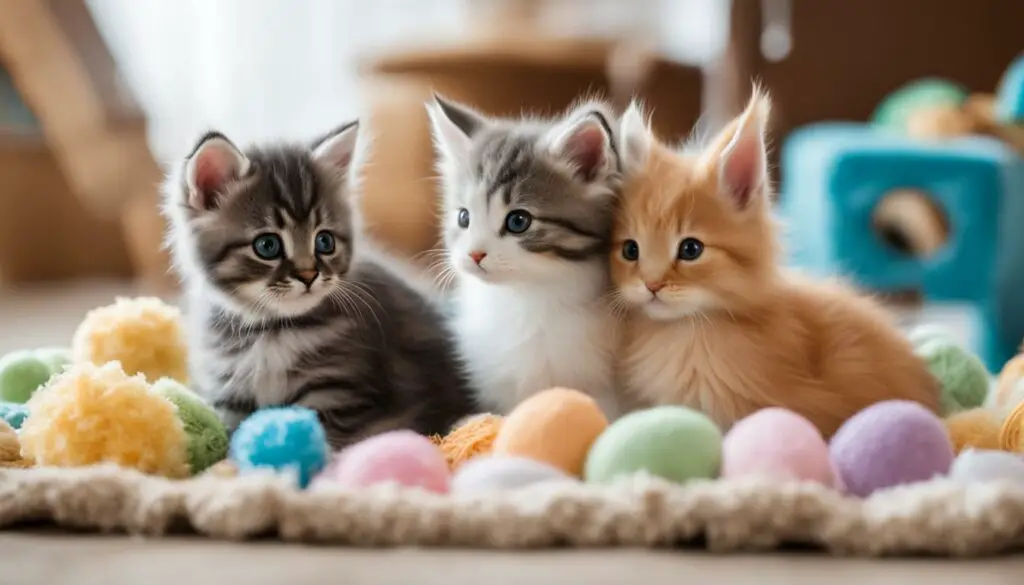
The Benefits of Introducing Cats and Bunnies at a Young Age:
- Promotes familiarity and bond-building
- Reduces the likelihood of aggression or fear-based behavior
- Allows for adaptability and openness to new experiences
- Increases the chances of a harmonious relationship
By introducing cats and rabbits at a young age, you are setting the foundation for a potentially lifelong friendship. However, it is important to note that individual animal personalities and temperaments also play a significant role in their compatibility. In the next section, we will explore the impact of temperament on cat and bunny relationships.
Cat and Rabbit Temperaments: Key Factors for a Harmonious Relationship
When considering whether cats and rabbits can get along, it’s important to take into account the temperament of both animals. Each animal has its unique personality, and these traits play a significant role in determining how well they will interact and potentially form a bond. Cats that are calm and submissive tend to have a better chance of getting along with rabbits, while rabbits that are assertive, but not aggressive, are more likely to establish a harmonious relationship.
It’s important to note that a submissive rabbit living in constant fear is at risk of developing gut stasis, which is a potentially life-threatening condition. Therefore, it’s crucial to create an environment where both animals feel safe and secure. Understanding their individual temperaments and providing appropriate care and attention can help prevent potential conflicts and foster a positive relationship.
“Cats that are calm and submissive tend to have a better chance of getting along with rabbits, while rabbits that are assertive, but not aggressive, are more likely to establish a harmonious relationship.”
Additionally, it’s essential to consider the cat’s prey drive and the rabbit’s sociability. Cats have a natural instinct to chase and hunt, which can be triggered by the movements of a rabbit. While some cats may be able to control their prey drive, it’s important to monitor their behavior closely during the introduction process. On the other hand, rabbits are social animals and may try to establish dominance within their living space. Balancing these natural instincts and ensuring that both animals feel secure is crucial for a successful cat and bunny relationship.
Table: Key Temperament Traits for Cats and Rabbits
| Cat Temperament | Rabbit Temperament |
|---|---|
| Calm | Assertive, not aggressive |
| Submissive | Not fearful or constantly stressed |
| Less prey-driven | Sociable |
By understanding the temperaments of both cats and rabbits, and providing an environment that supports their individual needs, the chances of establishing a harmonious cat and bunny household can be significantly increased. Patience, careful observation, and gradually introducing the animals while ensuring their safety and comfort are key to building a positive relationship between your feline and lagomorph companions.
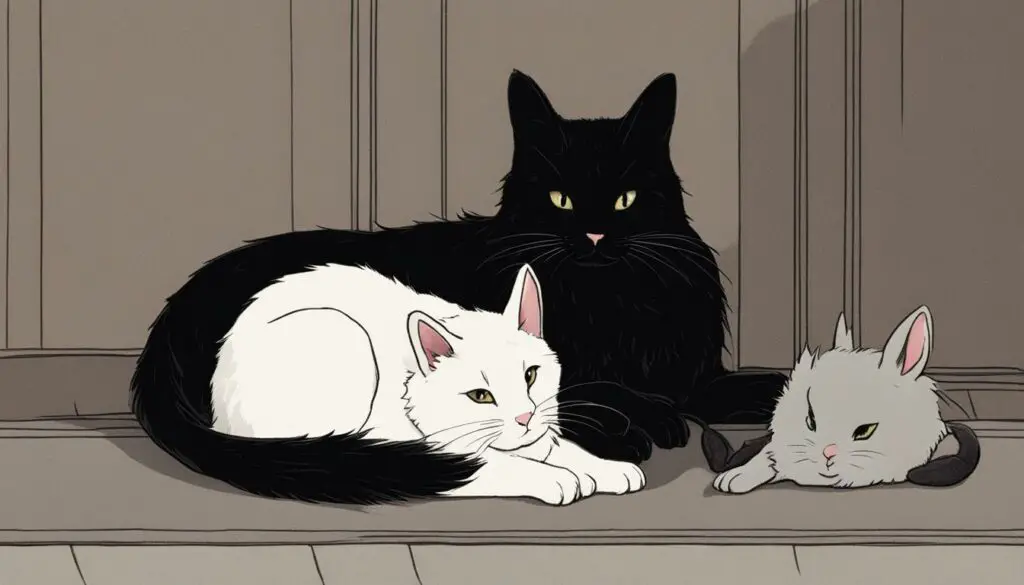
Remember that every cat and rabbit is unique, and it may take time for them to adjust to each other’s presence. It’s important to monitor their interactions, provide separate living spaces when needed, and seek professional guidance if any concerning behavior arises. With proper care and attention, a cat and rabbit can form a bond that brings joy to both their lives.
Size/breed of rabbit
When introducing cats and rabbits, it’s important to consider the size and breed of the rabbit. Matching cats and rabbits that are similar in size can help promote a more balanced relationship between the two animals. Some rabbit breeds can grow as large as medium-sized domestic house cats, and a significant size difference between the two can potentially lead to accidental harm or a power imbalance.
By ensuring that the cat and rabbit are comparable in size, you can reduce the risk of any unwarranted aggressive behavior or dominance struggles. A more balanced physical presence can facilitate a smoother introduction and create a safer and more harmonious environment for both animals.
If you are considering introducing a larger breed of rabbit, such as a Flemish Giant or a French Lop, it’s important to be mindful of their potential size. These breeds can grow to be quite large and may require additional space and accommodations in the household. Providing a suitable living environment for both the cat and the rabbit is crucial to their overall well-being and the success of their relationship.
Table: Comparison of Common Cat Breeds and Rabbit Sizes
| Cat Breed | Average Weight | Rabbit Size Comparison |
|---|---|---|
| Maine Coon | 10-25 lbs | Similar to a large to medium-sized rabbit |
| Siamese | 8-12 lbs | Similar to a small to medium-sized rabbit |
| Persian | 7-12 lbs | Similar to a small to medium-sized rabbit |
Note: The size comparison is a general guideline and may vary depending on individual cat and rabbit sizes.
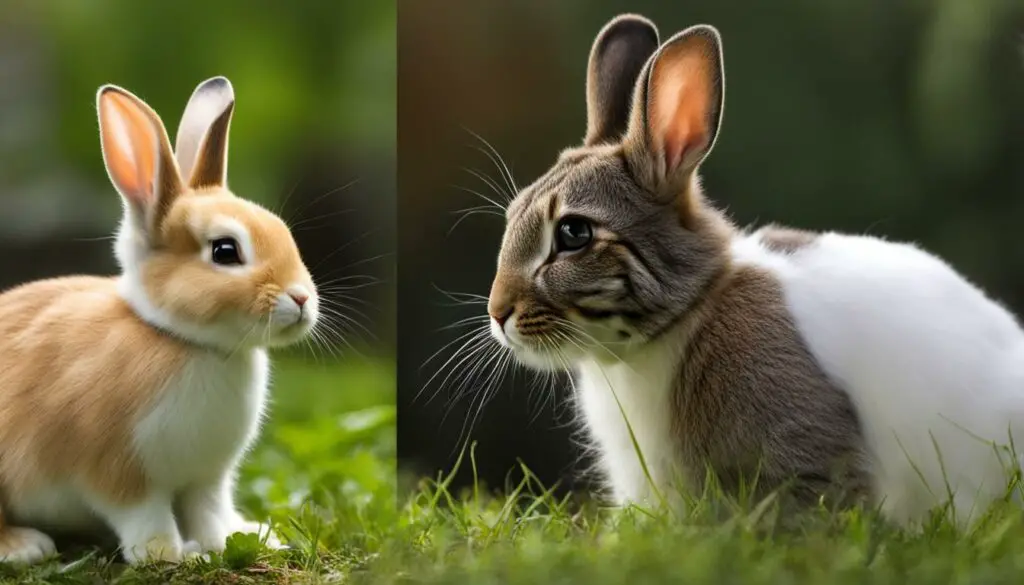
Considering the size and breed of the rabbit is just one aspect of creating a harmonious cat and bunny household. It’s essential to also consider other factors such as age of introduction, temperament of both animals, and their natural instincts. With careful planning and gradual introductions, cats and rabbits can potentially develop a positive and enriching relationship in your home.
How to Introduce Cats and Rabbits
Introducing cats and rabbits requires a slow and careful approach to ensure their safety and promote positive interactions. Here are some tips for successfully introducing these two animals:
-
Vaccinate and Spay/Neuter: Before introducing your cat and rabbit, make sure both animals are up to date on their vaccinations. This helps prevent the spread of diseases between species. Additionally, spaying and neutering both cats and rabbits can reduce aggression and territorial instincts, making the introduction process smoother.
-
Gradual Introduction: Start by keeping the cat and rabbit separate and gradually introduce them in a controlled environment. This can involve allowing the cat to watch and sniff the rabbit’s cage, then letting the rabbit out while the cat is restrained. As both animals become more comfortable, you can increase their interaction time. However, if the rabbit runs and the cat chases, separate them and start the introduction process again more slowly.
-
Supervised Interactions: Always supervise the interactions between your cat and rabbit, especially during the early stages of their introduction. This allows you to prevent any aggressive or predatory behavior and intervene if necessary.
-
Separate Living Spaces: Provide separate living spaces for the cat and rabbit, at least initially. This gives each animal a safe retreat and prevents any territorial disputes. They can gradually become accustomed to each other’s presence through smells and sounds before being allowed to interact more freely.
-
Playtime for the Cat: To satisfy your cat’s hunting instincts and divert their attention from the rabbit, provide separate playtime for your feline friend. Engage in interactive play sessions using toys that simulate hunting. This helps keep their focus away from the rabbit and promotes a more harmonious environment.
By following these tips and being patient throughout the introduction process, you can increase the chances of a successful relationship between your cat and rabbit.
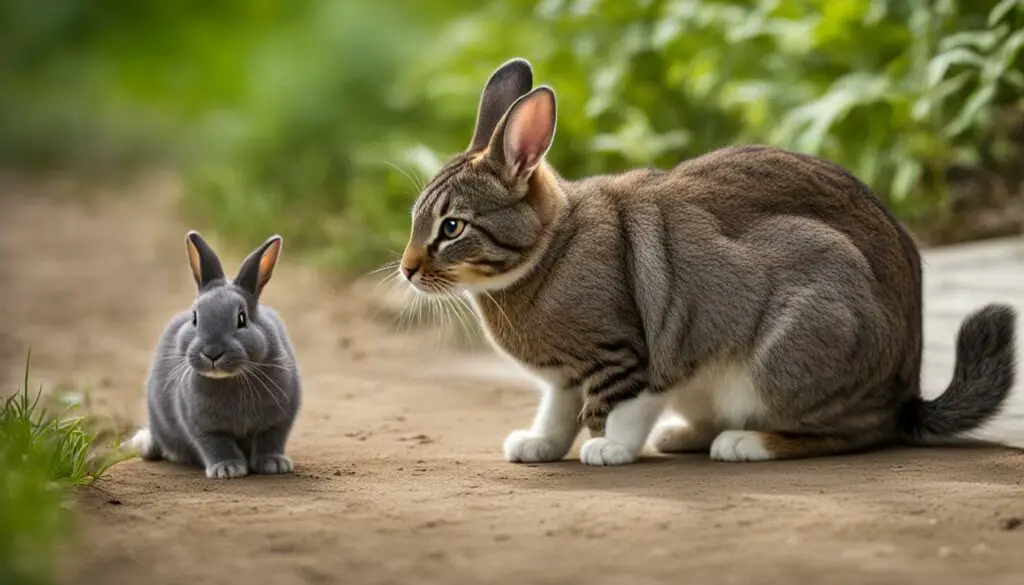
| Step | Tip |
|---|---|
| 1 | Vaccinate and Spay/Neuter |
| 2 | Gradual Introduction |
| 3 | Supervised Interactions |
| 4 | Separate Living Spaces |
| 5 | Playtime for the Cat |
Vaccinate and Spay/Neuter
Before introducing cats and rabbits, it is crucial to prioritize their health by ensuring that both animals are up to date on their vaccinations. Vaccinations help prevent the spread of diseases between species and create a safer environment for everyone involved. Consult with your veterinarian to determine the appropriate vaccinations for your cat and rabbit.
In addition to vaccinations, spaying and neutering both cats and rabbits can play a significant role in reducing aggression and territorial instincts. Spaying and neutering not only help manage their reproductive health but also promote a calmer demeanor, making the introduction process smoother and increasing the chances of a harmonious relationship.
| Cat Vaccinations | Rabbit Vaccinations |
|---|---|
| Rabies | Myxomatosis |
| Distemper | Rabbit Hemorrhagic Disease |
| Feline Viral Rhinotracheitis | Calicivirus |
| Feline Calicivirus | Virulent Rabbit Hemorrhagic Disease |
Note: The table above shows common vaccinations for cats and rabbits, but the specific vaccines recommended may vary based on your pet’s health, location, and other factors. Consult with your veterinarian for personalized vaccination recommendations.
Reducing Aggression in Cats and Rabbits
In addition to vaccinations and spaying/neutering, there are other measures you can take to reduce aggression in both cats and rabbits. Providing each animal with their own space and resources, such as separate litter boxes, food bowls, and hiding spots, can help alleviate territorial disputes and promote a more peaceful coexistence.
Enriching their environment with toys, scratching posts, and interactive play sessions can also help channel their energy in a positive way and reduce the likelihood of aggressive behavior. Regular exercise and mental stimulation are important for both cats and rabbits to prevent boredom and frustration.
Remember to always observe the interactions between your cat and rabbit and intervene if any signs of aggression or stress arise. It’s better to separate them and seek professional advice than risk injury to either animal.
By prioritizing their health, providing separate spaces, and offering enrichment opportunities, you can create a safer and more harmonious environment for both cats and rabbits.

Introduce them slowly
When bringing cats and rabbits together, it’s important to introduce them slowly and carefully. Gradual introductions help ensure the safety of both animals and increase the likelihood of a positive outcome. Here are some key steps to follow during the introduction process:
- Separation: Begin by keeping the cat and rabbit in separate living spaces. This allows them to become familiar with each other’s scent without direct interaction.
- Supervised interaction: Once both animals seem comfortable with each other’s presence, you can proceed to supervised interactions. This can involve allowing the cat to observe the rabbit from a distance while being restrained.
- Gradual exposure: Over time, you can gradually increase the level of exposure between the cat and rabbit. This may include allowing the rabbit to roam freely while the cat is on a leash or behind a baby gate.
- Monitor behavior: Pay close attention to the behavior of both animals during their interactions. Look for signs of aggression or stress, and be prepared to separate them if necessary.
It’s important to note that every cat and rabbit is unique, and the introduction process may vary depending on their individual personalities. Patience and consistency are key to ensuring a successful and harmonious relationship between the two.
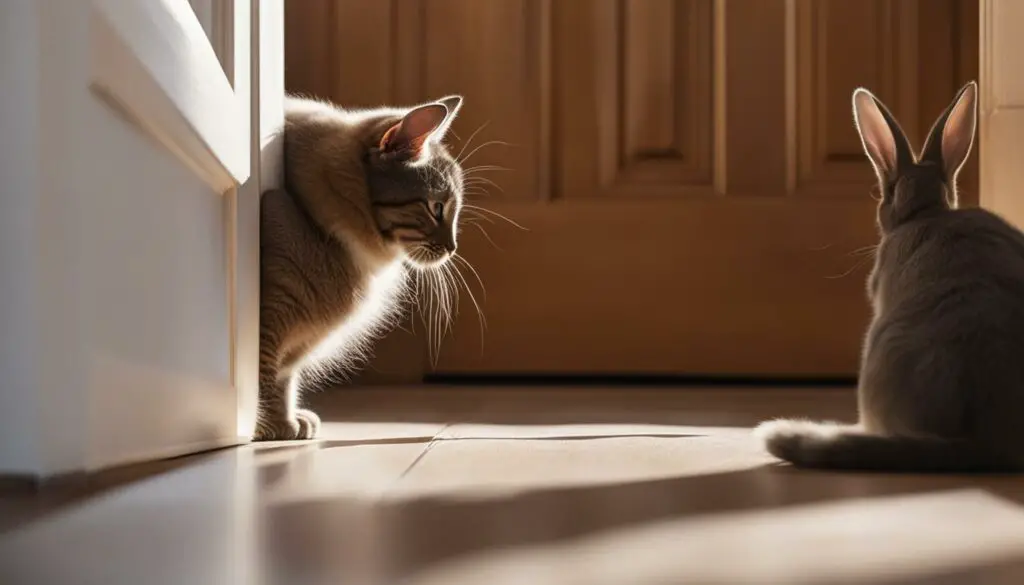
Allow the cat to observe the rabbit
One effective technique during the introduction process is allowing the cat to observe the rabbit from a safe distance. This can help the cat become familiar with the rabbit’s presence without feeling threatened. You can achieve this by placing the rabbit’s enclosure in a common area where the cat spends time. This allows the cat to observe the rabbit’s behavior and scent, helping them become comfortable with each other over time.
Gradual introductions play a crucial role in establishing a positive relationship between cats and rabbits. By allowing the cat to observe the rabbit and gradually increasing their exposure, we can help reduce the likelihood of aggressive behavior and promote a harmonious coexistence.
Rabbit charging cat
| Cat | Rabbit | |
|---|---|---|
| Size | Varies depending on breed and individual | Varies depending on breed and individual |
| Temperament | Varies; some cats may be more assertive or territorial | Varies; some rabbits may exhibit territorial behavior |
| Prey Drive | Instinctual hunting behavior towards smaller animals | Generally sociable, but individual rabbits may differ |
| Aggression | May exhibit aggression towards rabbits, especially if seen as prey | May exhibit aggression towards cats if feeling threatened |
Table: Key factors to consider when introducing a cat and rabbit
Play with your cat separately
When introducing cats and rabbits, it’s important to provide separate playtime for your cat to satisfy their hunting instincts. By engaging in interactive play sessions with your cat, you can help redirect their focus and prevent them from channeling their energy towards the rabbit.
Play sessions should involve toys that simulate hunting, such as feather wands, interactive puzzles, or treat-dispensing toys. These toys can help keep your cat mentally stimulated and physically active, reducing the likelihood of them becoming fixated on the rabbit.
“Separate playtime allows your cat to indulge in their natural hunting instincts in a controlled environment, while also creating a positive association with play that is separate from the rabbit.”
Providing a safe and stimulating environment
Creating a safe and stimulating environment for your cat is essential for their overall well-being. This includes providing scratching posts, vertical spaces for climbing, and interactive toys. By meeting your cat’s needs for mental and physical stimulation, you can help prevent boredom and potential behavioral issues.
Additionally, it’s important to provide a designated space for your cat’s playtime that is separate from the area where the rabbit resides. This can be a separate room or a designated corner of a room where you can engage in play sessions with your cat without the presence of the rabbit.
Benefits of separate playtime for both cat and rabbit
Separate playtime not only benefits your cat but also helps create a more peaceful environment for both the cat and the rabbit. By providing your cat with a dedicated playtime, you can satisfy their hunting instincts and reduce their focus on the rabbit, minimizing the potential for stress or aggression.
Furthermore, separate play sessions allow the rabbit to feel safe and secure in their own space without the presence of a potentially predatory cat. This can help foster a sense of calm and promote a more positive interaction between the two animals when they are in each other’s presence.
“By ensuring separate playtime for your cat, you can create a harmonious environment for both your cat and rabbit, facilitating a more positive and successful introduction.”
| Cat Playtime Tips | Benefits for Cat | Benefits for Rabbit |
|---|---|---|
| Engage in interactive play sessions with hunting toys | Satisfies natural hunting instincts | Reduces stress and potential aggression |
| Provide vertical spaces and scratching posts | Prevents boredom and behavioral issues | Promotes a sense of calm and security |
| Designate a separate play area for the cat | Creates a positive association with play | Allows the rabbit to feel safe and secure |
By incorporating separate playtime into your cat and rabbit routine, you can help ensure a harmonious and enjoyable relationship between the two animals.
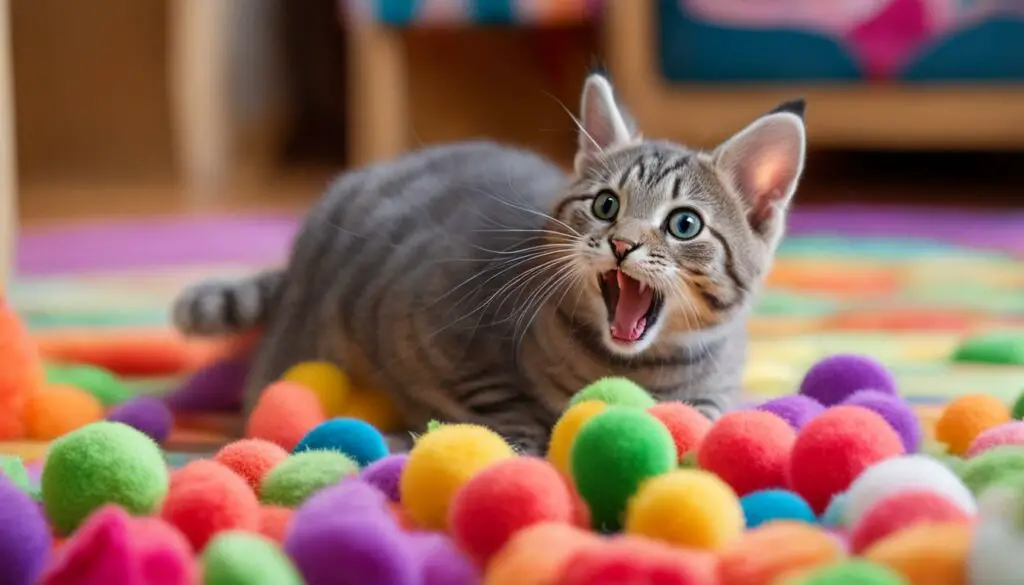
Do cats and rabbits get along?
Many people wonder if cats and rabbits can become friends and form a harmonious relationship. While it is possible for cats and bunnies to get along under the right circumstances, there are several factors to consider. The compatibility between cats and rabbits depends on their age of introduction, temperament, and size/breed dynamics.
When introducing cats and rabbits, it is best to do so when they are young. Young animals are more adaptable and have a higher chance of accepting a new companion. However, adult cats can also learn to coexist with rabbits with careful introduction and monitoring.
The temperament of both the cat and the rabbit plays a significant role in determining their compatibility. Calm and submissive cats are more likely to get along with rabbits, while rabbits that are assertive but not aggressive are more inclined to establish a positive relationship. It is important to ensure that both animals feel safe and comfortable in their environment.
| Cat Personality | Rabbit Personality |
|---|---|
| Calm and submissive | Assertive but not aggressive |
| Sociable | Establishing dominance in their living space |
The size and breed of the rabbit can also impact the dynamics between cats and rabbits. Matching cats and rabbits that are similar in size can help reduce the risk of accidental harm and promote a more balanced relationship.
While cats and rabbits can form a bond and live harmoniously together, it is important to prioritize the needs of both animals and be prepared for the possibility that they may always need to be separated. Each cat and rabbit is unique, and it may take time and effort to establish a bond between them.
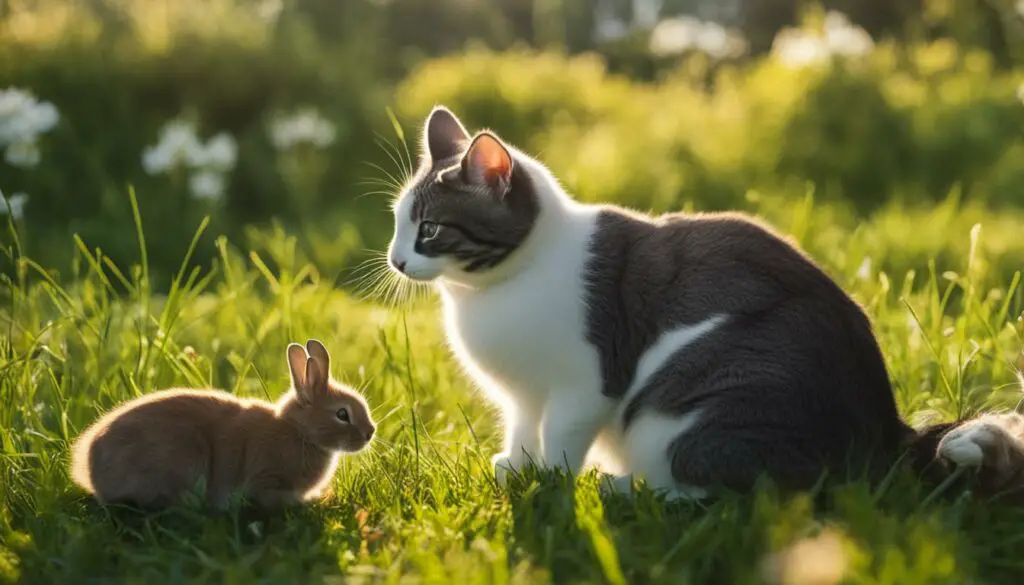
How to Remove the Predator-Prey Context
When bringing cats and rabbits into the same household, it’s important to create a safe environment that removes the predator-prey context. By understanding their natural instincts and providing the right conditions, you can foster a harmonious relationship between these two species.
To create a safe environment, start by understanding the behaviors of both cats and rabbits. Cats have a natural prey drive, so it’s essential to provide outlets for their hunting instincts through interactive play sessions. This helps redirect their energy and focus away from the rabbit. Additionally, rabbits are sociable animals that may establish dominance in their living space, so providing separate areas for each pet allows them to feel secure and prevents territorial aggression.
In the initial introduction phase, it’s crucial to provide a neutral space where both animals can meet without feeling threatened. This could be a gated area or a room where the rabbit has its enclosure, and the cat can observe from a distance. Gradually allow supervised interactions, ensuring that both pets feel comfortable and relaxed. If any signs of aggression or fear arise, separate them immediately and take a step back in the introduction process.
| Cats | Rabbits |
|---|---|
| Strong prey drive | Sociable and territorial |
| Redirect energy through play | Provide separate living spaces |
| Supervised introductions | Create a neutral introduction area |
Understanding the Natural Instincts
When considering a cat and bunny relationship, it’s important to understand the natural instincts of both animals. Cats have a strong prey drive, which means they are instinctively inclined to chase and hunt smaller animals, such as rabbits. This predator-prey dynamic can pose a challenge when trying to introduce cats and rabbits and create a harmonious living environment.
On the other hand, rabbits are sociable animals that establish dominance within their living space. They have a territorial behavior and may exhibit assertive behaviors, such as marking their territory or charging at other animals. Understanding and managing these natural instincts is vital to ensure the well-being and safety of both the cat and the rabbit.
“Cats have a natural prey drive, and some cats may see rabbits as prey and display hunting behavior.”
The Role of Prey Drive in Cats
Cats have an innate instinct to chase and capture small prey. This behavior is deeply rooted in their DNA and can be challenging to suppress completely. It’s important to acknowledge that some cats may see rabbits as potential prey and exhibit hunting behaviors. This can include stalking, pouncing, and even attempting to bite or catch the rabbit.
To manage a cat’s prey drive, it’s crucial to provide them with appropriate outlets for their hunting instincts. Engaging in interactive play sessions with toys that simulate prey can help satisfy their natural instincts and redirect their focus away from the rabbit. Additionally, ensuring the cat has plenty of mental and physical stimulation through playtime and environmental enrichment can help reduce their predatory behavior.
Establishing Dominance in Rabbits
Rabbits, on the other hand, are social animals that establish dominance within their living space. They have a territorial behavior and may exhibit assertive behaviors when interacting with other animals, including cats. This can include charging at the cat, nudging, or thumping their hind legs to display dominance.
It’s important to provide rabbits with a safe space where they can establish their territory and feel secure. This can be achieved by providing them with separate living areas initially and gradually introducing them to each other’s presence under controlled supervision. Creating a neutral introduction area can help prevent territorial conflicts and promote a more positive encounter between the cat and the rabbit.
Overall, understanding and managing the natural instincts of both cats and rabbits is crucial when considering a cat and bunny relationship. By providing appropriate outlets for a cat’s prey drive and creating a safe environment for rabbits to establish their territory, it’s possible to foster a harmonious living environment for both animals.
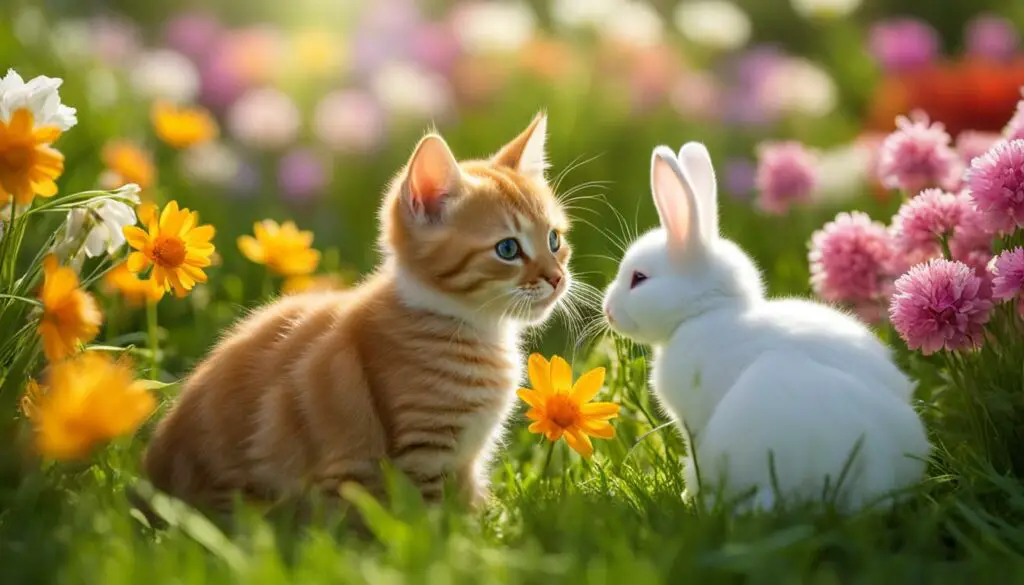
Cat and Rabbit Personalities: Understanding Compatibility
When considering introducing a cat and a rabbit into your household, it’s important to take their personalities into account. The compatibility of their personalities plays a significant role in determining how well they will get along. Aggressive or dominant behavior in either the cat or the rabbit can hinder the establishment of a harmonious relationship.
The Cat’s Personality
Cats, known for their individuality, can have varying temperaments. Some cats are calm and sociable, while others may be more aloof or even aggressive. If you’re considering adding a cat to your household, it’s important to choose one that has a calm and friendly disposition. Cats that exhibit aggressive behavior towards other animals are less likely to form a bond with a rabbit.
The Rabbit’s Personality
Rabbits also have distinct personalities. Some rabbits are outgoing and sociable, while others may be more timid or territorial. When selecting a rabbit to join your household, look for one that is calm and non-aggressive. Rabbits that exhibit territorial behavior or dominance may have difficulties getting along with a cat.
| Cat Personality | Rabbit Personality | Compatibility |
|---|---|---|
| Calm and sociable | Calm and non-aggressive | High |
| Aggressive or dominant | Timid or territorial | Low |
By choosing a cat and a rabbit with compatible personalities, you increase the chances of them forming a bond and living harmoniously together. However, it’s important to note that individual personalities can vary, and there are no guarantees that every cat and rabbit will get along. Patience, careful introductions, and ongoing monitoring are crucial to ensuring the well-being of both animals.
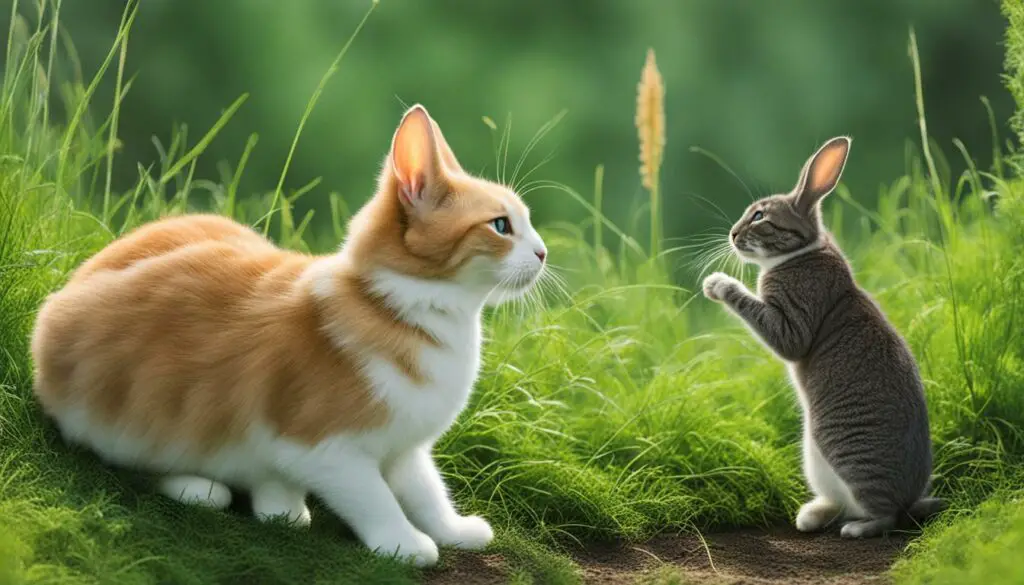
“Understanding the personalities of both cats and rabbits is crucial when introducing them. Calm and sociable cats, along with calm and non-aggressive rabbits, have a higher chance of forming a harmonious relationship. However, it’s important to remember that every animal is unique, and compatibility can vary.” – Pet Behavior Expert
Risks and Safety Measures
When introducing cats and rabbits, it’s important to be aware of the potential risks and take appropriate safety measures. Cats have natural prey instincts, and rabbits can display territorial aggression, which can lead to conflict if not managed properly.
Cat prey instincts are deeply ingrained, and they may see rabbits as prey animals. This can manifest in chasing, pouncing, or even attacking the rabbit. To mitigate this risk, it’s crucial to keep the cat’s nails trimmed to minimize potential harm to the rabbit. Additionally, close supervision is necessary during their interactions to intervene if any aggressive behavior occurs.
Rabbits, on the other hand, can exhibit territorial aggression when they feel their space is being invaded. This might involve charging, biting, or displaying other defensive behaviors. To ensure the safety of both animals, it’s essential to provide separate living spaces initially and gradually introduce them in a controlled environment, such as a neutral introduction area. This can help prevent territorial conflicts and give both the cat and the rabbit time to adjust to each other’s presence.
| Risk | Safety Measure |
|---|---|
| Cat prey instincts | Keep cat’s nails trimmed Supervise interactions closely |
| Rabbit territorial aggression | Provide separate living spaces initially Gradually introduce in a neutral area |
Remember, each cat and rabbit is unique, and their behavior may vary. It’s essential to closely observe their interactions and monitor their body language for any signs of distress or aggression. If necessary, consult with a professional, such as a veterinarian or animal behaviorist, for guidance in managing their relationship.
Slow and Careful Introductions
Introducing cats and rabbits requires a gradual approach to ensure a positive relationship between the two. It is important to proceed with caution and take the necessary steps to create a safe and harmonious environment for both animals.
Gradual Introductions
When bringing a new cat or rabbit into the household, it is best to start with separate living spaces. This allows each animal to become familiar with their surroundings and establish a sense of security. Gradually, you can begin to introduce them to each other’s scents by swapping bedding or placing them in separate rooms with a cracked door for sniffing and observation. Slowly increasing their exposure to one another will help prevent any initial fear or aggression.
Supervised Interactions
As the animals become more comfortable with each other’s presence, supervised interactions can be introduced. This can involve allowing them to see and sniff one another through a baby gate or using a leash for the cat to maintain control during initial face-to-face encounters. It is important to closely monitor their behavior and separate them immediately if any signs of aggression or fear arise.
Separate Living Spaces
While cats and rabbits may eventually form a bond, it is crucial to provide separate living spaces to ensure their safety and well-being. Each animal should have their own designated area with access to food, water, litter boxes, and hiding spots. This allows them to have a space of their own and reduces the chances of territory-related conflicts.
Neutral Introduction Area
When the time comes for a more direct introduction, creating a neutral space can help prevent territorial behavior and promote a more positive encounter. This can be a neutral room or an outdoor space where neither animal has established dominance. By starting on neutral ground, it can help reduce any potential aggression and give them an equal footing to establish their own relationship.
| Benefits of Slow and Careful Introductions |
|---|
| Minimizes the risk of aggressive behavior |
| Promotes a gradual bond between the animals |
| Allows for close monitoring of their interactions |
| Reduces the likelihood of territorial conflicts |
| Provides a safe and controlled environment for both animals |
Conclusion
In conclusion, the relationship between cats and bunnies can be a harmonious one, but it requires careful consideration and proper introductions. Understanding the natural instincts of both animals, such as the cat’s prey drive and the rabbit’s sociability, is crucial in fostering a positive bond between them.
By introducing cats and rabbits at a young age, matching their temperaments, and ensuring they are similar in size, the chances of them getting along increase significantly. Gradual introductions, supervised interactions, and separate living spaces initially are key in establishing a safe and comfortable environment for both animals.
While it’s important to remember that not all cats and rabbits will become best friends, with patience, monitoring, and proper care, it is possible to create a harmonious cat and bunny household. Each cat and rabbit are unique individuals, and it may take time and effort for them to establish a bond. Ultimately, prioritizing their needs and ensuring their safety should be the top priority in any cat and bunny relationship.
FAQ
Do cats and bunnies get along?
Yes, under the right circumstances, cats and bunnies can form a harmonious relationship.
What factors determine the compatibility between cats and rabbits?
The age of introduction, temperament of both animals, and size/breed of the rabbit can play a role in determining how well they get along.
Can adult cats and rabbits get along?
It is possible for adult cats to accept a new bunny family member, or vice versa, but it requires careful introduction.
What should I consider about cat and bunny behavior?
Cats are natural predators and rabbits are prey animals, so understanding their instincts is important when considering a cat and bunny relationship.
Should I match the size of the cat and rabbit?
Yes, it is recommended to match cats and rabbits that are similar in size to reduce the risk of accidental harm.
How should I introduce cats and rabbits?
Introduce them slowly and carefully, vaccinate and spay/neuter both animals, and provide separate playtime for the cat to engage in their hunting instincts.
Why is it important to vaccinate and spay/neuter both cats and rabbits?
This helps prevent the spread of diseases between species and reduces aggression and territorial instincts.
What safety measures should I take when introducing cats and rabbits?
Keep their nails trimmed, provide proper supervision, and have safety equipment on hand.
How should I remove the predator-prey context?
Create a safe environment by understanding their behaviors, providing a neutral introduction space, and gradually allowing them to get used to each other’s presence.
Can cats and rabbits ever be friends?
Yes, under the right circumstances, some cats and rabbits can form a bond. However, it is important to prioritize the needs of both animals and be prepared for the possibility that they may always need to be separated.
How should I handle natural instincts in cats and rabbits?
Understand and manage their natural instincts such as prey drive in cats and territorial behavior in rabbits.
What are the risks involved when introducing cats and rabbits?
There are risks due to cats’ prey instincts and rabbits’ territorial aggression, so taking safety measures is crucial.
How should I approach the introduction process?
Introduce cats and rabbits slowly, with gradual interactions, supervision, and separate living spaces initially. A neutral introduction area can help prevent territorial behavior.
Should I play with my cat separately?
Yes, providing separate playtime for your cat helps satisfy their hunting instincts and keeps their focus away from the rabbit.
Can cats and rabbits form a harmonious relationship?
Yes, under the right circumstances, cats and rabbits can get along and form a bond.
How can I foster a harmonious cat and bunny household?
Understanding their needs and behaviors, introducing them slowly, and providing proper care and supervision are crucial for creating a harmonious environment.
What are the concluding thoughts on the cat and bunny relationship?
Each cat and rabbit are individuals, and it may take time and effort to establish a bond between them. Prioritizing their needs and being prepared for the possibility of separation is important.

